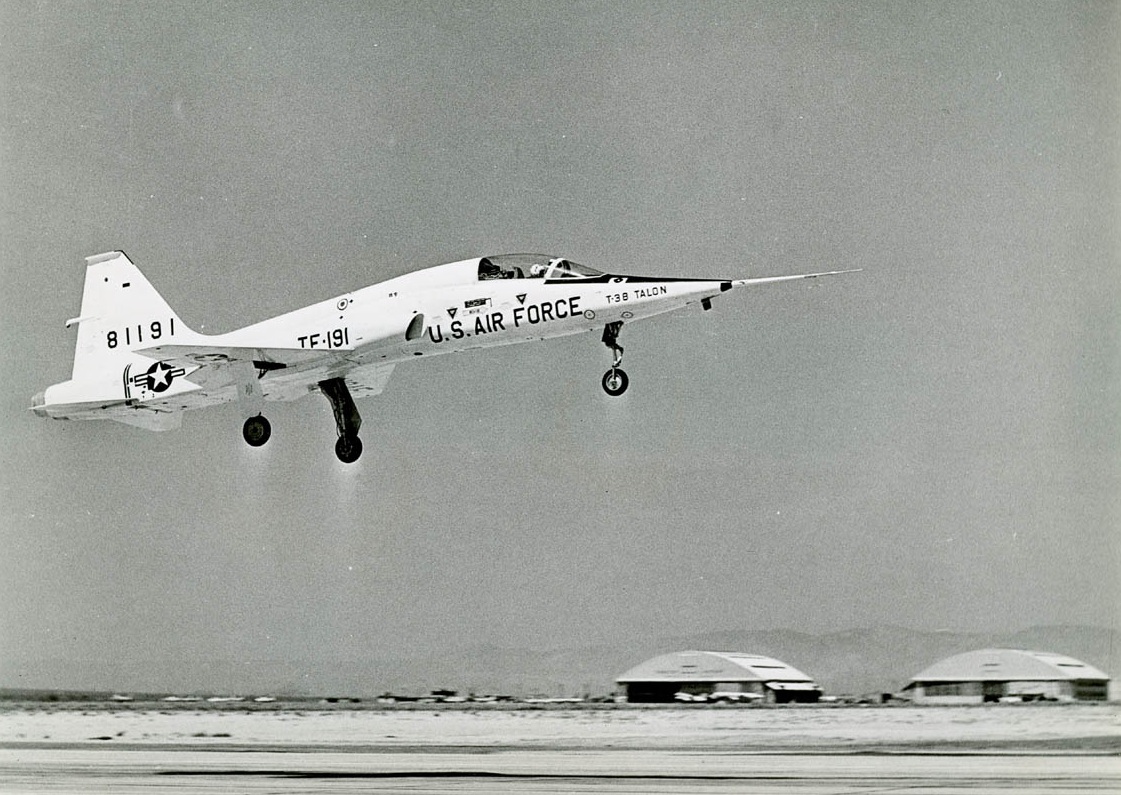
![]() 10 April 1959: Northrop test pilot Lewis A. Nelson made the first takeoff of the prototype YT-38-5-NO Talon, serial number 58-1191, at Edwards Air Force Base, California.
10 April 1959: Northrop test pilot Lewis A. Nelson made the first takeoff of the prototype YT-38-5-NO Talon, serial number 58-1191, at Edwards Air Force Base, California.
A private venture by Northrop, the Talon was designed by a team led by Edgar Schmued, famous for his work on the North American Aviation P-51 Mustang, F-86 Sabre and the F-100 Super Sabre. The Talon is a twin-engine advanced trainer capable of supersonic speeds. More than 5,500 hours of wind tunnel testing was performed before the airplane’s final configuration was determined.
After testing, the two YT-38s were modified to the YT-38A configuration. The modified aircraft was accepted by the United States Air Force and ordered into production as the T-38A Talon.
The T-38 was the world’s first supersonic flight trainer. The Northrop T-38A Talon is a pressurized, two-place, twin-engine, jet trainer. Its fuselage is very aerodynamically clean and uses the “area-rule” (“coked”) to improve its supersonic capability. It is 46 feet, 4.5 inches (14.135 meters) long with a wingspan of 25 feet, 3 inches (7.696 meters) and overall height of 12 feet, 10.5 inches (3.924 meters). The one-piece wing has an area of 170 square feet (15.79 square meters). The leading edge is swept 32º. The airplane’s empty weight is 7,200 pounds (3,266 kilograms) and maximum takeoff weight is approximately 12,700 pounds (5,761 kilograms).
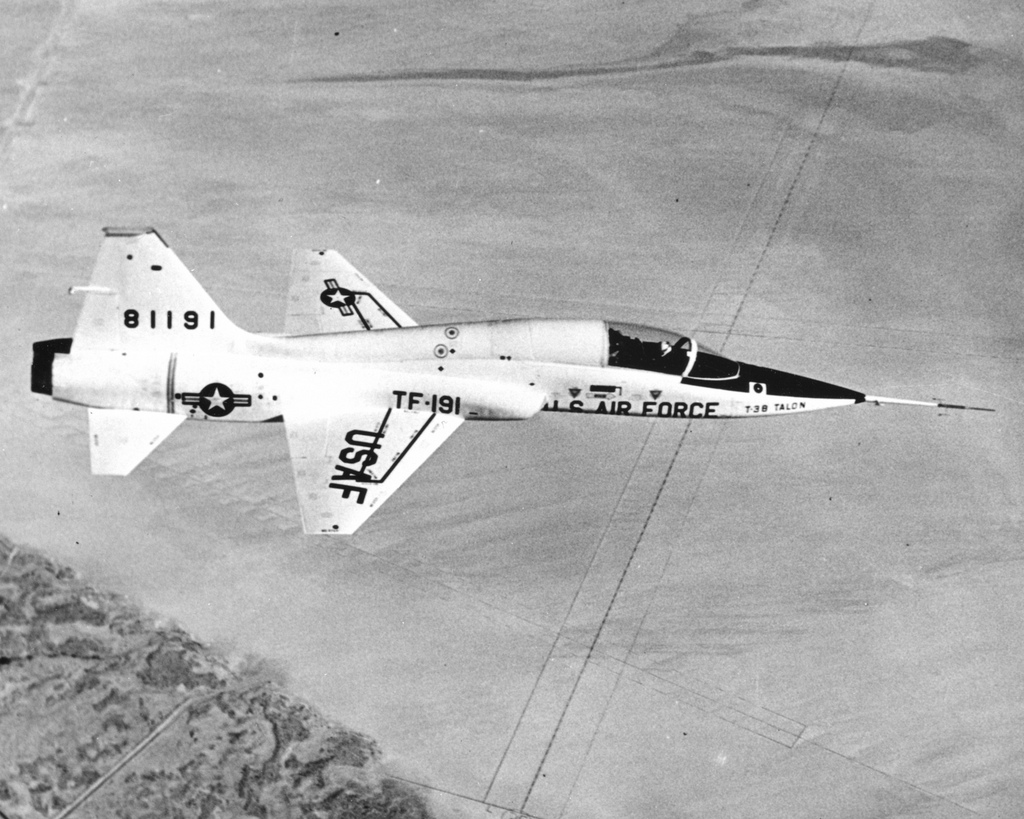
The T-38A is powered by two General Electric J85-GE-5 turbojet engines. The J85 is a single-shaft axial-flow turbojet engine with an 8-stage compressor section and 2-stage turbine. The J85-GE-5 is rated at 2,680 pounds of thrust (11.921 kilonewtons), and 3,850 pounds (17.126 kilonewtons) with afterburner. It is 108.1 inches (2.746 meters) long, 22.0 inches (0.559 meters) in diameter and weighs 584 pounds (265 kilograms).
The T-38A has a maximum speed of Mach 1.08 (822 miles per hour/1,323 kilometers per hour) at Sea Level, and Mach 1.3 (882 miles per hour/1,419 kilometers per hour) at 30,000 feet (9,144 meters). It has a rate of climb of 33,600 feet per minute (171 meters per second) and a service ceiling of 55,000 feet (16,764 meters). Its range is 1,140 miles (1,835 kilometers).

Between 1959 and 1972, 1,187 T-38s were built at Northrop’s Hawthorne, California factory. As of 2014, 546 T-38s remained in the U.S. Air Force active inventory. The U.S. Navy has 10, and NASA operates 15.
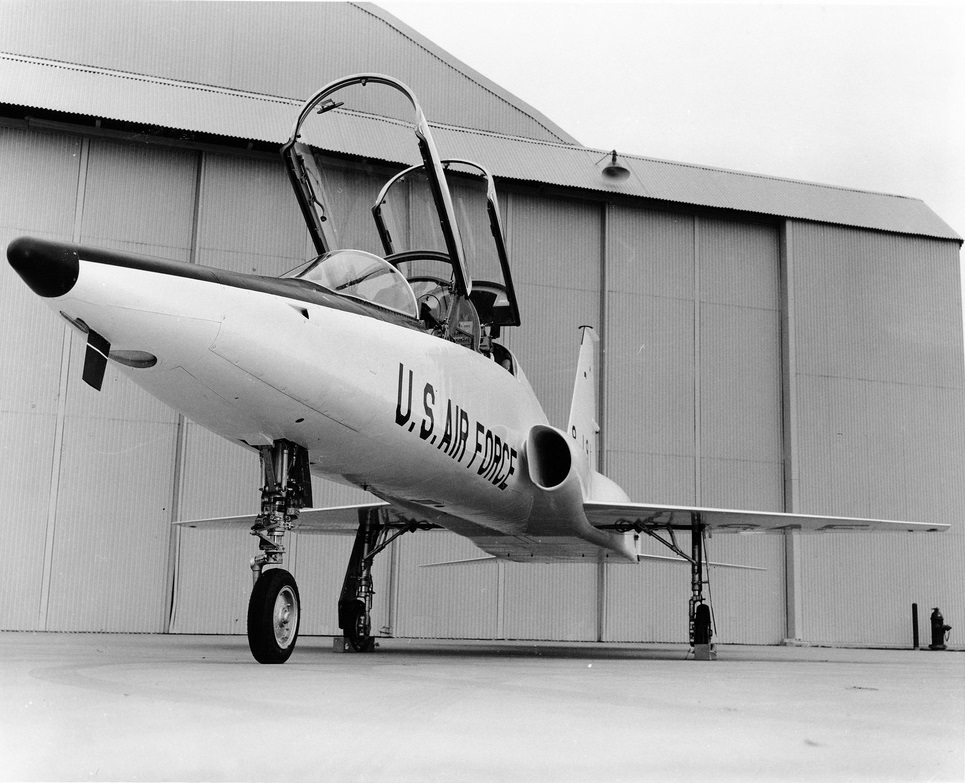
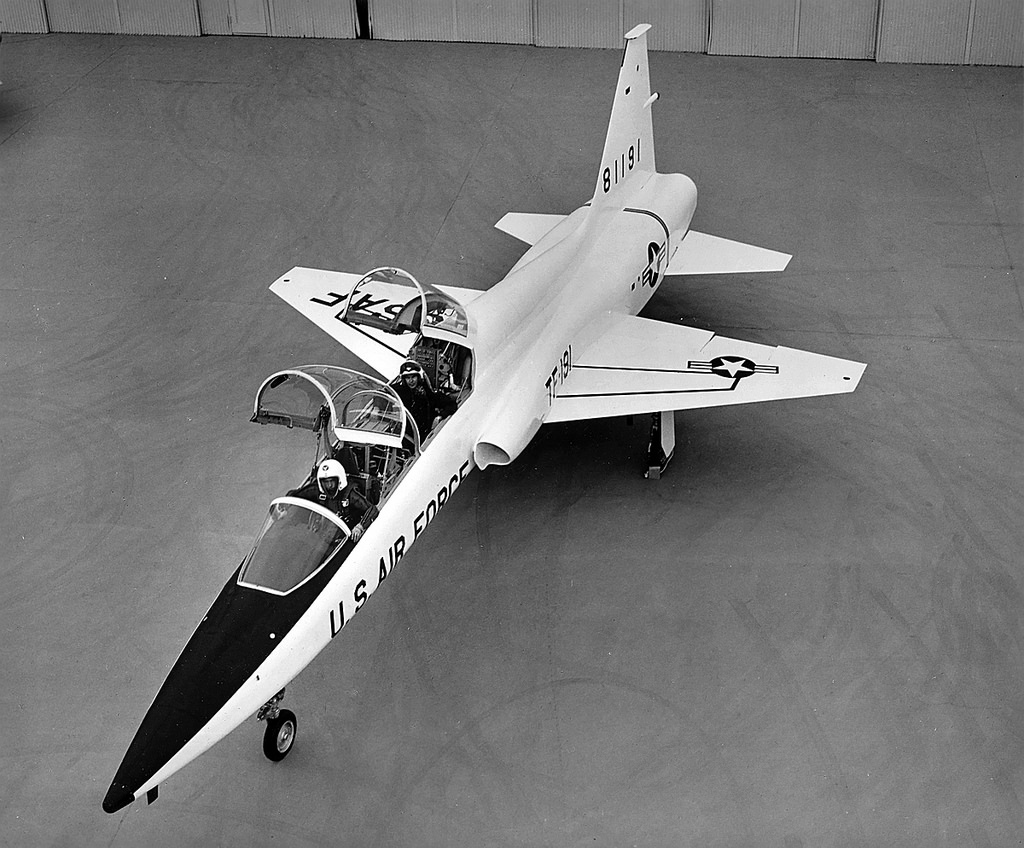
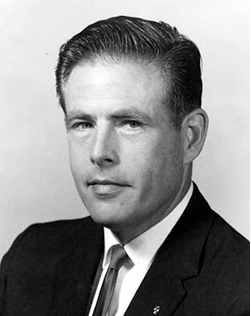
Lewis Albert Nelson was born 13 September 1920 at San Diego, California, the second of three children of George Walter Nelson, an electrician, and Edith Clarissa Merrill Nelson. He grew up in Santa Cruz, California.
Nelson first flew in a Piper J-3 Cub as a teenager. While attending a junior college in 1939, he was accepted into the Civilian Pilot Training Program and continued while at San Jose State College, San Jose, California.
Nelson enlisted as an aviation cadet in the U.S. Army Air Corps at Moffett Field, California, 12 January 1942. He was 5 feet, 7 inches (1.702 meters) tall and weighed 154 pounds (69.9 kilograms). He served until 1947. He was twice awarded the Distinguished Flying Cross.
After leaving the Air Corps, Nelson studied aeronautical engineering at the University of Southern California (USC) in Los Angeles, graduating in 1949. He later earned a master’s degree from the University of California, Los Angeles (UCLA).
Lew Nelson worked as an aeronautical engineer for the National Advisory Commission on Aeronautics (NACA), and joined the Northrop Corporation as a test pilot in 1950. In 1952 he was promoted to Chief Experimental Test Pilot. Nelson made the first flights of a number of Northrop aircraft, such as the F-89 Scorpion, N-156 and F-5. Nelson retired from Northrop in 1986.
He married Elaine M. Miller, Clark County, Nevada, 28 April 1979.
Lewis Albert Nelson died at Menifee, California, 15 January 2015, at the age of 94 years. His remains were buried at sea.
© 2019, Bryan R. Swopes

“Since 1962, every pilot in the United States Air Force has been trained in the T-38.” I am almost 100% certain, without looking it up to verify, that this statement is factually incorrect. First, almost all helicopter pilots in the USAF are not even close to getting in a T-38. Since about 1992 or so, the way pilot training in the USAF has been managed means that only pilots, after initial training, who are tracked to fly fighters or the B-1 are flying T-38s. Pilots tracked for mobility aircraft are not flying a supersonic trainer.
Now having double checked at least one source: Since 1992 T-38s are flown by F-15, F-16, B-52, B-1, B-2, A-10, F-22, and F-35 tracked pilots after they complete primary training in the T-6. There are also flown by U-2 and B-2 pilots for proficiency (and used to be used by F-117 pilots for the same purpose). Pilots going on to fly tanker and airlift aircraft fly T-1 Jayhawks after they complete training in T-6s.
Thank you, John. You are correct, of course. Change made.
Partially correct. Since 2009 some mobility, special operations, tanker and even rpa pilots have trained in the T-38 as a way to balance T-1 student load.
Back in my time, everyone at UPT went from the tweet to the T-38. However, to fly fighters, you had to FAR qualified. Fighter, Attack, Recce. So no matter what assignment you got out of pilot training, you were considered “Universally Qualified”. So if you had a heavy assignment, you can later transition to a fighter.
Would guess Edgar Schmued was one of the best aircraft designers. Working for North American and Northrop he is responsible for designing the P-51 the F-86 the F-100 and the F-5/T-38! Quite a list of classics! Flown all but the 51.
I may be wrong, but think Craig AFB flew T-33’s beyond 1962.
I flew the T-33 at Peterson Field in 1969.
How many of you that flew the T-38 in UPT remember the day you soloed that machine the first time? As I recall my helmet was not big enough.
Terry,
I think we were in the same UPT Class, different sections, at Vance AFB, 72-03.
Absolutely loved flying the T-38 … from Day One in UPT. Felt miles behind it the first few rides (the Tweet and I only tolerated each other) but greatly appreciated the Talon’s precise flight characteristics. Learned a lot in that jet … lessons I took along to fly the F-15, F-5E and MiG-21. Eventually became dual qualified in the MiG and T-38 … even backseat landing qualified … not too spooky! Don’t specifically recall my T-38 initial solo, but lots of good memories in that jet.
Thanks, Brian. I think that it proves the old saying that airplanes that look good, fly good. –Bryan
Hi Bryan,
I’m trying to contact the person (or people) who run the ‘Thisdayinaviationhistory’ site to ask them some questions about the photos they use. We’re making a documentary called Arctic Aviators and would like to use some of the photos, but need to know who owns the copyright for them. I therefore wondered, as a contributor to the site, if you could point me in the right direction so I could properly contact them.
Hope you can help.
Best, Justin
Hi, Justin. I am TDiA, all by myself. To the best of my knowledge, the majority of the images used in “This Day in Aviation” are in the public domain. Others are used with the specific permission of the photographers, and are so credited. There are some that are from the Internet but without attribution. I usually label those “unattributed.”
Didn’t Edgar Schmued work for Focke Wulf before he emigrated to the USA? I seem to recall he brought with him some of the ideas that made it into the P-51. In any event, he was a brilliant designer and his airplanes were as aesthetically beautiful as they were efficient and fast.
I think there was a rumor that he worked for Messerschmitt and worked on the Bf 109, but from what I can find, his first aviation engineering work was for a subsidiary of General Motors in South America. When he came to the United States, he worked at Fokker. I should probably do some more research on this, so I can give a definitive answer. Thanks, Andrew.
I recall flying a solo “out and back” in the T-38 from Moody AFB to an AFB near Macon, GA. Approach control gave me a straight-in from around 10 miles out and told me I would be #2 behind a C-141. Everything seemed OK, but the runway looked further away than I thought it should. Pretty soon I figured it out. I had misread the altimeter and was at 12,000 ft rather than 2,000. I requested to circle on the approach to “check out something”. Just one of many.
(chuckle) Max, I have *never* done anything like that. 🙂 —Bryan
Craig AFB still had T-33s into 1967. I was in class 67-G and only the second class to fly the T-38 there. I believe Craig was the last training base to fly the T-33.
As a farm boy as early as 5 years old or so, I remember on many days watching what seemed at times an endless string of these white “rocket ships” flying really low from the west, and then turning north when they were overhead our house.
As I got a little older, I learned what they were and where they were going… I was always fascinated by their sleekness and speed, and the crackling noise they made as they sliced through the air. I found myself drawing pictures of them.
After turning 14, I got a Honda, and on some Saturdays, I made the 15 mile journey north, parked outside the fence by the runways of Vance AFB… I sat mesmerized while watching the T-38 “Talons” do their afterburner takeoffs, as well as their touch-and-goes…. It became apparent that our farm, 3 1/2 miles west of Hennessey, OK was pretty close to the T-38 VFR entry point when they were landing to the north.
In retrospect, in spite of being in awe of these sleek flying machines as a kid, I don’t remember back then ever having the thought of me actually flying one someday. I guess the prospect was about as realistic as me going to the moon.
Fast forward to 6 May 1980, as I lifted off on my T-38 solo ride on a southbound takeoff from Reese AFB, TX. I VIVIDLY recall the sounds, sensations, weather… and the silence from the back seat… realizing that although my instructor pilot was not there, it was like his ghost WAS! And I recall telling myself, “This farm boy is havin’ a blast!”
The SAC Looking Glass was my first assignment, allowing me to fly the T-38 for another 3 years in the ACE program. One of my highlights was taking a weekend trip in the 38, which included a stop at Tinker AFB in Oklahoma City for gas and a “Tinker-burger”… then we took off and jumped into Vance’s traffic pattern and did a low level 360 around my farm while Mom & Dad stood in the front yard and waved at us! Needless to say, I left that program dragging my feet, on my way to my next assignment.
My last Air Force assignment was as an E-4B Nightwatch (B-747) instructor/evaluator pilot and Chief of Stan/Eval, 1st Airborne Command & Control Squadron, Offutt AFB.
5 years ago this month, I retired from 25 years with Delta Air Lines, having piloted the 727, 737, 757 and 767.
Over the years, I have often had flashbacks of watching those white rockets over our farm… realizing that somehow, that childhood experience helped shape my future.
I worked on the last one delivered and I remember the First Flight or at least the story as told by the NAD Chief Inspector, J. Martin Sr.
From 1971 to 1991 The 479 Tactical Training Wing @ Holloman AFB equipped with the AT38B for the Lead-In Fighter Training for new pilots with assignments to F-15, F-16, A-10, B-1 along with currency for pilots retuning to Fighter/Attack cockpits. The AT-38B was modified with a gun sight and centerline station to carry either a SUU-20 rocket/bomb dispenser or a SUU11 7.62mm gun pod.